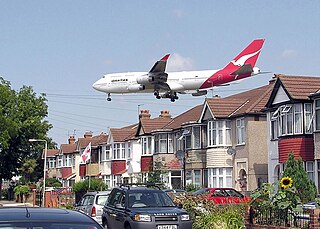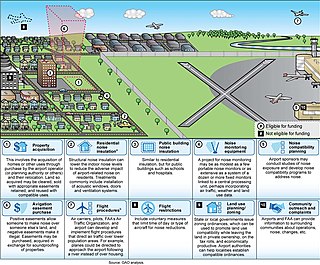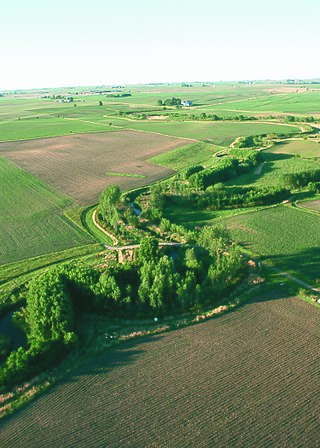Related Research Articles

Noise is unwanted sound considered unpleasant, loud, or disruptive to hearing. From a physics standpoint, there is no distinction between noise and desired sound, as both are vibrations through a medium, such as air or water. The difference arises when the brain receives and perceives a sound.

Noise pollution, or sound pollution, is the propagation of noise or sound with ranging impacts on the activity of human or animal life, most of which are harmful to a degree. The source of outdoor noise worldwide is mainly caused by machines, transport and propagation systems. Poor urban planning may give rise to noise disintegration or pollution, side-by-side industrial and residential buildings can result in noise pollution in the residential areas. Some of the main sources of noise in residential areas include loud music, transportation, lawn care maintenance, construction, electrical generators, wind turbines, explosions and people.

Natura 2000 is a network of nature protection areas in the territory of the European Union. It is made up of Special Areas of Conservation and Special Protection Areas designated under the Habitats Directive and the Birds Directive, respectively. The network includes both terrestrial and Marine Protected Areas.

Environmental noise is an accumulation of noise pollution that occurs outside. This noise can be caused by transport, industrial, and recreational activities.

The Department for Environment, Food and Rural Affairs (DEFRA) is a department of His Majesty's Government in the United Kingdom responsible for environmental protection, food production and standards, agriculture, fisheries and rural communities in the entire United Kingdom. Concordats set out agreed frameworks for co operation, between it and the Scottish Government, Welsh Government and Northern Ireland Executive, which have devolved responsibilities for these matters in their respective nations.
A soundscape is the acoustic environment as perceived by humans, in context. The term was originally coined by Michael Southworth, and popularised by R. Murray Schafer. There is a varied history of the use of soundscape depending on discipline, ranging from urban design to wildlife ecology to computer science. An important distinction is to separate soundscape from the broader acoustic environment. The acoustic environment is the combination of all the acoustic resources, natural and artificial, within a given area as modified by the environment. The International Organization for Standardization (ISO) standardized these definitions in 2014.

Waste hierarchy is a tool used in the evaluation of processes that protect the environment alongside resource and energy consumption from most favourable to least favourable actions. The hierarchy establishes preferred program priorities based on sustainability. To be sustainable, waste management cannot be solved only with technical end-of-pipe solutions and an integrated approach is necessary.
The best available technology or best available techniques (BAT) is the technology approved by legislators or regulators for meeting output standards for a particular process, such as pollution abatement. Similar terms are best practicable means or best practicable environmental option. BAT is a moving target on practices, since developing societal values and advancing techniques may change what is currently regarded as "reasonably achievable", "best practicable" and "best available".
Tranquillity is the quality or state of being tranquil; that is, calm, serene, and worry-free. The word tranquillity appears in numerous texts ranging from the religious writings of Buddhism—where the term passaddhi refers to tranquillity of the body, thoughts, and consciousness on the path to enlightenment—to an assortment of policy and planning guidance documents, where interpretation of the word is typically linked to engagement with the natural environment. It is also famously used in the Preamble to the United States Constitution, which describes one of the purposes for which the document was establishing the government as to "insure domestic Tranquility".
Water supply and sanitation (WSS) in the European Union (EU) is the responsibility of each member state, but in the 21st century union-wide policies have come into effect. Water resources are limited and supply and sanitation systems are under pressure from urbanisation and climate change. Indeed, the stakes are high as the European Environmental Agency found that one European out of ten already suffers a situation of water scarcity and the IEA measured the energy consumption of the water sector to be equivalent to 3,5% of the electricity consumption of the EU.
The Commissioner for Environment, Oceans and Fisheries is a member of the European Commission. The current Commissioner is Virginijus Sinkevičius, who also serves as EU Commissioner for the Environment.
Environmental Quality is a set of properties and characteristics of the environment, either generalized or local, as they impinge on human beings and other organisms. It is a measure of the condition of an environment relative to the requirements of one or more species, any human need or purpose.

In 2015, 43.5% of the United Kingdom's municipal waste was recycled, composted or broken down by anaerobic digestion. The majority of recycling undertaken in the United Kingdom is done by statutory authorities, although commercial and industrial waste is chiefly processed by private companies. Local Authorities are responsible for the collection of municipal waste and operate contracts which are usually kerbside collection schemes. The Household Waste Recycling Act 2003 required local authorities in England to provide every household with a separate collection of at least two types of recyclable materials by 2010. Recycling policy is devolved to the administrations of Scotland, Northern Ireland and Wales who set their own targets, but all statistics are reported to Eurostat.

A noise map is a graphic representation of the sound level distribution and the propagation of sound waves in a given region, for a defined period.

The Urban Waste Water Treatment Directive 1991 European Union directive concerning urban waste water "collection, treatment and discharge of urban waste water and the treatment and discharge of waste water from certain industrial sectors". It aims "to protect the environment from adverse effects of waste water discharges from cities and "certain industrial sectors". Council Directive 91/271/EEC on Urban Wastewater Treatment was adopted on 21 May 1991, amended by the Commission Directive 98/15/EC.

Soundscape ecology is the study of the acoustic relationships between living organisms, human and other, and their environment, whether the organisms are marine or terrestrial. First appearing in the Handbook for Acoustic Ecology edited by Barry Truax, in 1978, the term has occasionally been used, sometimes interchangeably, with the term acoustic ecology. Soundscape ecologists also study the relationships between the three basic sources of sound that comprise the soundscape: those generated by organisms are referred to as the biophony; those from non-biological natural categories are classified as the geophony, and those produced by humans, the anthropophony.

The European Union (EU) Environmental Policy was initiated in 1973 with the "Environmental Action Programme" at which point the Environmental Unit was formed. The policy has thereafter evolved "to cover a vast landscape of different topics enacted over many decades" (Reuters) and in 2015 the Institute for European Environmental Policy estimated that "the body of EU environmental law" amounted to 500+ directives, regulations and decisions.
"Over the past decades the European Union has put in place a broad range of environmental legislation. As a result, air, water and soil pollution has significantly been reduced. Chemicals legislation has been modernised and the use of many toxic or hazardous substances has been restricted. Today, EU citizens enjoy some of the best water quality in the world"
The Environmental noise directive (END) 2002/49/EC is a directive from the European Union to give information to the public about the noise levels in their living environment, and to assess and manage environmental noise. The directive was adopted in the year 2000.
Since the late 1970s, the European Union's (EU) policy has been to develop and drive appropriate measures to improve air quality throughout the EU. The control of emissions from mobile sources, improving fuel quality and promoting and integrating environmental protection requirements into the transport and energy sector are part of these aims.

Nature-based solutions (NBS) is the sustainable management and use of natural features and processes to tackle socio-environmental issues. These issues include climate change, water security, water pollution, food security, human health, biodiversity loss, and disaster risk management. The European Commission's definition of NBS states that these solutions are "inspired and supported by nature, which are cost-effective, simultaneously provide environmental, social and economic benefits and help build resilience. Such solutions bring more, and more diverse, nature and natural features and processes into cities, landscapes, and seascapes, through locally adapted, resource-efficient and systemic interventions". In 2020, the EC definition was updated to further emphasise that "Nature-based solutions must benefit biodiversity and support the delivery of a range of ecosystem services." Through the use of NBS healthy, resilient, and diverse ecosystems can provide solutions for the benefit of both societies and overall biodiversity.
References
- 1 2 Cerwén, Gunnar; Mossberg, Frans (7 January 2019). "Implementation of Quiet Areas in Sweden". Int. J. Environ. Res. Public Health. 16 (134): 134. doi: 10.3390/ijerph16010134 . PMC 6339113 . PMID 30621011.
- ↑ Cage, John (1973). Silence: lectures and writings. Hanover, N.H.: Wesleyan University Press. ISBN 0819560286.
- 1 2 3 Cerwén, Gunnar (2017). Sound in Landscape Architecture: A Soundscape Approach to Noise. Alnarp: SLU. ISBN 9789177600725.
- ↑ Goldsmith, Mike (2012). Discord: the story of noise. Oxford: Oxford University Press. ISBN 9780199600687.
- ↑ WHO (2018). Environmental Noise Guidelines for the European Region. Regional Office for Europe: Copenhagen, Denmark.: World Health Organization.
- ↑ Schafer, Murray (1977). Soundscape: The Tuning of the World. Rochester, VT: Destiny Books.
- ↑ Commission of the European Communities (1996). Future Noise Policy. European Commission (Green Paper ed.). Brussels: Commission of the European Communities.
- 1 2 EU (2002). Directive 2002/49/EC of the European Parliament and of the Council Relating to the Assessment and Management of Environmental Noise. Official Journal of the European Communities: L 189: European Union.
{{cite book}}: CS1 maint: location (link) - 1 2 European Environment Agency (2014). Good Practice Guide on Quiet Areas. Luxembourg: Publications Office of the European Union.
- 1 2 European Environment Agency (2016). Quiet Areas in Europe: The Environment Unaffected by Noise Pollution. Luxembourg: Publications Office of the European Union.
- ↑ "Quietness Suitability Index". EEA. European Environmenal Agency.
- ↑ "Interactive map". DEFRA. 10 December 2015.
- ↑ Radicchi, Antonella; Henckel, Dietrich; Memmel, Martin (2018). "Citizens as smart, active sensors for a quiet andjust city. The case of the "open sourcesoundscapes" approach to identify, assess and plan "everyday quiet areas" in cities". Noise Mapp. 5 (1): 1–20. doi: 10.1515/noise-2018-0001 . hdl: 11365/1233643 . S2CID 134846108.
- ↑ Berlin Senate (2020). Lärmaktionsplan Berlin 2019-2023. Berlin: Senatsverwaltung für Umwelt, Verkehr und Klimaschutz Öffentlichkeitsarbeit.
- ↑ "Hush City".